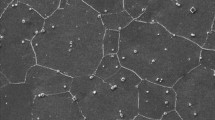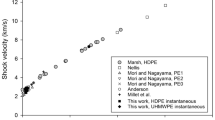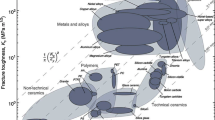Abstract
The results of dynamic tests for compression of four metals after annealing (aluminum alloy, copper, brass, stainless steel) in the range of strain rates 100–10,000 s–1 are presented. To obtain dynamic true stress-true plastic strain curves a specific dynamic upsetting computation method was used starting from time variation of force pulse. The high-speed loading of specimens with a height to diameter ratio equal to 1.5 was carried out using three experimental devices: a drop-hammer with a free-falling mass, a ram impact machine with rubber accelerators and an impact machine with powder acceleration. A technique for direct measuring the specimen temperature during plastic deformation using an “artificial specimen” thermocouple (specimen-thermocouple) was proposed, in which the deformable metal itself is the “hot” junction, while the “cold” junction is connected to the measuring instrument. A thermoelectrode made of an alloy of noble metals tungsten and rhenium with a diameter of 0.1 mm was welded to the specimen by radiation from a pulsed YAG:Nd3+ laser. As a result of the tests, true dynamic stress–strain diagrams and flow stress versus strain rate were obtained. Experimental estimation concerning self-heating temperature variation corresponding to high-speed plastic deformation at room temperature is also developed. Experiments for determining the temperature effect of plastic deformation of the samples after annealing during cold settling showed that at the high speed of ~ 50 m s−1 and high strain-rates of ~ 10,000 s−1 the increase in temperature of the specimens compressed to a degree of deformation of 0.6 reached 55 °C for an aluminum alloy, 60 °C for copper, 80 °C for brass and 140 °C for stainless steel.







Similar content being viewed by others
References
Taylor G (1948) The use of flat-ended projectiles for determining dynamic yield stress. I. Theoretical considerations. Proc R Soc Lond A. 194:289–299
Fyfe IM, Rajendran AM (1980) Dynamic pre-strain and inertia effects on the fracture of metals. J Mech Phys Solids 28:17–26
Daniel IM, LaBedz RH, Liber T (1981) New method for testing composites at very high strain rates. Exp Mech 21(2):71–77
Dharan CKH, Hauser FE (1970) Determination of stress-strain characteristics at very high strain rates. Exp Mech 10:370–376
Klepaczko J (2001) Advanced experimental techniques in materials testing. In: Nowacki WK, Klepaczko JR (eds) New experimental methods in material dynamics and impact, trends in mechanics of materials. Warsaw, pp 1–58
Kolsky H (1949) An investigation of the mechanical properties of material at very high rates of loading. Proc Phys Soc B (London) 62:676–700
Chen W, Song B (2010) Split Hopkinson (Kolsky) bar: design, testing and applications (mechanical engineering series). Springer, New York, p 388
Johnson GR, Cook WN (1983) A constitutive model and data for metals subjected to large strains. High strain rates and high temperatures. In: Proceedings seventh international symposium on ballistics, Hague (Netherlands), 19–21 Apr 1983. Roy. Inst. of Engrs in the Netherlands, Hague, pp 541–547
Taylor GI, Quinney H (1934) The latent energy remaining in a metal after cold working. Proc R Soc Ser A 143:307–326
Mason JJ, Rosakis AJ, Ravichandran G (1994) On the strain and strain rate dependence of the fraction of plastic work converted into heat: an experimental study using high speed infrared detectors and the Kolsky bar. Mech Mater 17(2/3):135–145
Kapoor R, Nemat-Nasser S (1998) Determination of temperature rise during high strain rate deformation. Mech Mater 27(1):1–12
Nemat-Nasser S, Guo W-G, Nesterenko VF et al (2001) Dynamic response of conventional and hot isostatically pressed Ti–6Al–4V alloys: experiments and modeling. Mech Mater 33(8):425–439
Rosakis P, Rosakis AJ, Ravichandran G, Hodowany J (2000) A thermodynamic internal variable model for the partition of plastic work into heat and stored energy in metals. J Mech Phys Solids 48(3):581–607
Walley SM, Proud WG, Rae PJ, Field JE (2000) Comparison of two methods of measuring the rapid temperature rises in split Hopkinson bar specimens. Rev Sci Instrum 71(4):1766–1771
Sokolov LD (1963) Plastic deformation resistance of metals. Metallurgizdat, Moscow (in Russian)
Gubkin SI (1969) Plastic deformation of metals, vol 2. Metallurgizdat, Moscow (in Russian)
Pudovkin VD, Bragov AM (1979) Investigation of resistance of metal deformation under high-speed loading. Appl Probl Strenghth Plast. 12:132–142 (in Russian)
Herzig N, Abdel-Malek S, Meyer LW, Cimpoeru SJ (2017) Modeling of ductile failure in high strength steel. Procedia Eng 197:285–293
Hueto F, Hokka M, Sancho R, Rӓmӧ J, Ӧstman K, Gálvez F, Kuokkala V (2017) High temperature dynamic tension behavior of titanium tested with two different methods. Procedia Eng 197:130–139
Urakov VF (1967) The use of thermocouples to measure the temperature in a metal during its plastic deformation at elevated speeds. In: Machines and technology of metal forming. Metallurgizdat, Moscow (in Russian)
Kruszka L, Nowacki WK (1995) Thermoplastic analysis of normal impact of long cylindrical specimen: experiment and comparison with the numerical calculation. J Therm Stresses 18(3):313–334
Zukas JA (ed) (1990) High velocity impact dynamics. Wiley, New York
Follansbee PS, Regazzoni G, Kocks UF (1984) Transition to drag-controlled deformation in copper at high strain rates. Inst Phys Conf Ser 70:71–80
Couque H (2014) The use of the direct impact Hopkinson pressure bar technique to describe thermally activated and viscous regimes of metallic materials. Philos Trans R Soc A 372:20130218
Armstrong RW (2014) Bertram Hopkinson’s pioneering work and the dislocation mechanics of high rate deformations and mechanically induced detonations. Philos Trans R Soc A 372:20130181
Zerilli FJ, Armstrong RW (1987) Dislocation-mechanics-based constitutive equations for material dynamics calculations. J Appl Phys 61:1816–1825
Albertini C, Cadoni E, Solomos G (2014) Advances in the Hopkinson bar testing of irradiated/non-irradiated nuclear materials and large specimens. Philos Trans R Soc A 372:20130197
Gavrus A, Bucur F, Rotariu A, Cananau S (2015) Mechanical behavior analysis of metallic materials using a Finite Element modeling of the SHPB test, a numerical calibration of the bar’s elastic strains and an inverse analysis method. Int J Mater Form 8:567–579
Gavrus A (2012) Constitutive equation for description of metallic materials behavior during static and dynamic loadings taking into account important gradients of plastic deformation. Key Eng Mater 504–506:697–702
Acknowledgements
The dynamic experiments were supported by the grant of the Government of the Russian Federation (Contract No. 14.Y26.31.0031). The temperature effect of plastic deformation was investigated under partial financial support from the Russian Science Foundation (Grant 16–19-10237-P).
Author information
Authors and Affiliations
Corresponding author
Additional information
Publisher's Note
Springer Nature remains neutral with regard to jurisdictional claims in published maps and institutional affiliations.
Rights and permissions
About this article
Cite this article
Bragov, A., Igumnov, L., Konstantinov, A. et al. Effects of High Strain Rate and Self-heating on Plastic Deformation of Metal Materials Under Fast Compression Loading. J. dynamic behavior mater. 5, 309–319 (2019). https://doi.org/10.1007/s40870-019-00214-x
Received:
Revised:
Accepted:
Published:
Issue Date:
DOI: https://doi.org/10.1007/s40870-019-00214-x




